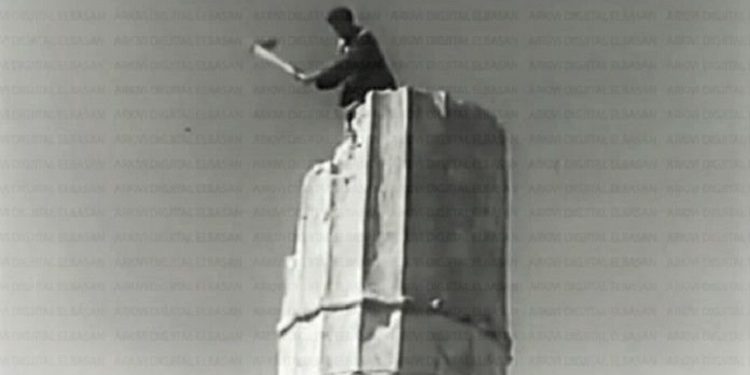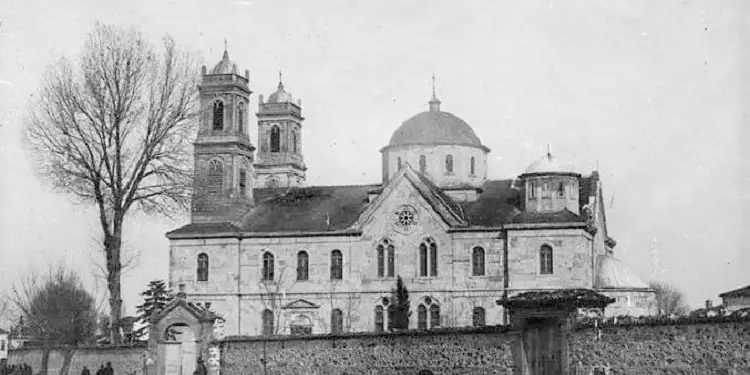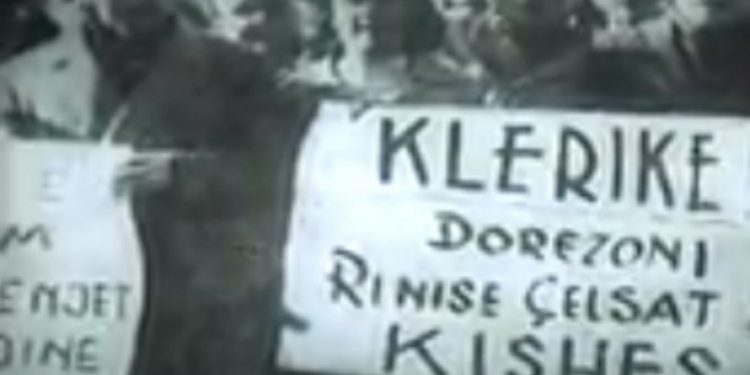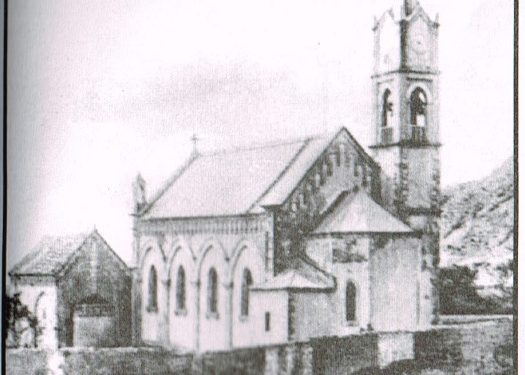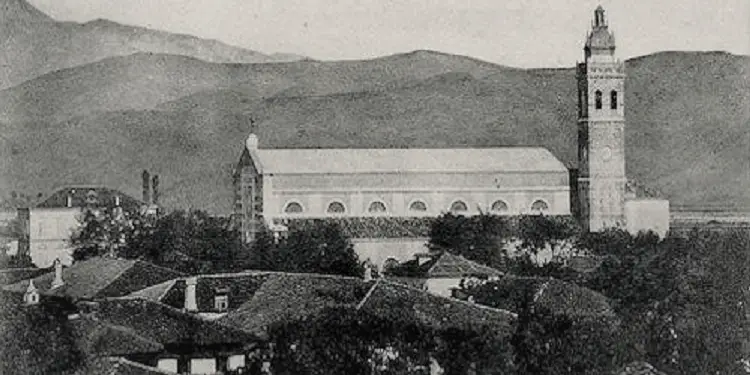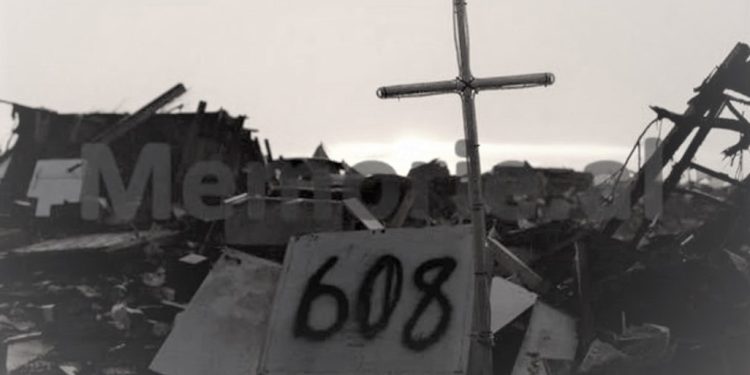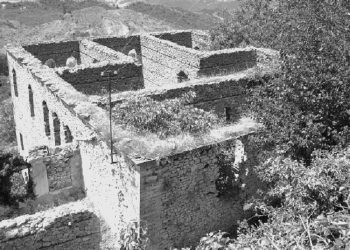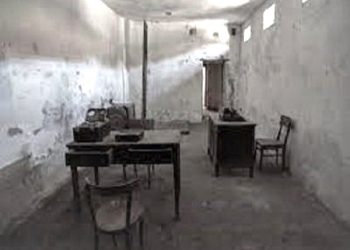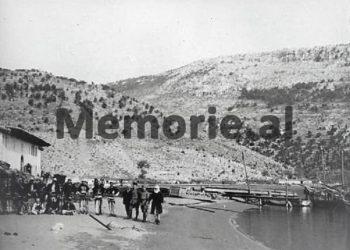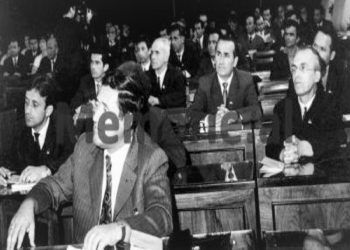From Luljeta Progni
“Cultural revolution”/ How cult objects were destroyed in our country
Memorie.al / It was the year 1967. The dictatorial regime had decided to give the final blow to religious faith, with terrorist acts that Albanians had never experienced before. With explosions of explosives, tanks and companies equipped with heavy equipment, 2,172 shrines were destroyed, including: 740 mosques, 609 Orthodox churches, 158 Catholic churches and 530 mosques. The centuries-old faith of Albanians in their religion, generation after generation, had been severely hit. Everyone had to believe only in the madness of a group of people, propagandizing the “Cultural Revolution”, which in essence, had the destruction of individual values and free thought, and replacing it with ignorance and devotion to the one party, which with at any cost, he had to stay in power.
Church of Saint Ndou, in Laç Kurbin
On the evening of June 12, 1967, a few hours before the believers left to celebrate the feast of Saint Ndout in Laç, (Kurbin), and two battalions surrounded the entire area around the church with heavy artillery, with a radius of 4 kilometers, to stop the annual pilgrimage. During that night, the next day, and the following days, artillery fire with mortars and cannons began. The place was designated as a military zone and the paths where the believers passed were closed.
Within a few months, until August 1967, all the temples of religious beliefs were leveled or turned into warehouses and cultural centers. Their stones, hewn for centuries, by the faith of the Albanians, placed on top of each other, to raise the holy shrine to God, were already falling under the violence of madness.
After the revanch against religious belief ended, in complete contradiction with the constitution of that time which still guaranteed all citizens freedom of conscience and religion, in November 1967, the regime issued decree no. 4337, canceling the legalization of religious communities and prohibited all rites.
St. George’s Cathedral, in the center of Korça
Once upon the Promenade of Saint George in Korça, the morning shadow of one of the most beautiful cathedrals in the Balkans, the one that had given its name to the promenade itself, the Cathedral of Saint George, fell. Today, the sounds of a violin and curious tourists stand over the traces of the Cathedral’s shadows, which resemble chalk marks left at a crime scene, in the middle of the city of Korça.
Saint George It was the symbol of Korça, the spiritual monument, declared the Protector of the city, temple of culture, art, architecture and our national heritage. It began to be built in 1881 and was inaugurated in 1905. The design and construction of this cathedral was done by the master Naum Trasha, a Korça master originally from Opari, who is also known as the builder of many stores in the Korça Market, while financially , helped patriots and philanthropists from Korça, such as Anastas Lakçe.
St. George’s Cathedral was not just one of the most beautiful cathedrals in the Balkans, but it had a special architecture, in a neoclassical style, too high for the constructions of the time, built all with carved stones, connected with lead bars, with the borders of the trees full of arabesques and aster decorations, with the large spherical domes, with the façade full of colored glass, and especially with the entrance, where at the top of the stairs rose a series of colonnades connected to each other, through beautiful arches, while inside it was decorated with polyeles or lampshades, which consisted of thousands of crystal glasses, surrounded by the magnificent wooden iconostasis, carved by the masters of the area. It was also part of the city’s history.
In this cathedral in 1914, by Father Josif Qirici, the first full mass in the Albanian language was held, while in 1923, Bishop Theofan Noli was canonically handed over, and it was there that the efforts for the Autocephaly of the Church began. Ceremonies were held there for princes and high officials visiting the city and for the first national government.
During the difficult times of various wars in the Balkans, Saint George was the home of various assemblies, where Albanian patriots participated, who did not even spare their lives to make the Albanian state.
After the windows were broken and the walls were stripped, the roof was removed and the walls, built with elaborately carved stones, began to crumble. The stones of the Cathedral were used to fill the Korca river bed and pave the city’s sidewalks.
The believers who spent every day among them with their heads down whispered prayers, while they felt that these stones of faith, uprooted from their temple, would not leave them at the mercy of evil, but would carry the memories, to bring back once their faith in God. Saddened, many of the Korcar believers continued to perform religious rites in secret.
While the “Antichrist” threw darkness over the spirit of the Albanians, many of the Korčar believers continued to perform their religious rites in secret, keeping the light of faith burning, the light of hope that one day they would resurrect their stones faith, with as much grandeur as St. George’s Cathedral.
King Mosque, Elbasan
Inside the stone walls of the Elbasan Castle, one of the most special Albanian castles in terms of the history it carries, built on the cobblestones of Egnatia Street, there is one of the most beloved temples of the Albanian Muslim faithful, Mosque Mbret.
It is one of the oldest mosques in Albania, built in the 15th century, with a special architectural style, covered with a wooden roof and a vestibule in front of the entrance; the walls consist of a very regular and precise combination of alternating stones with framing bricks. The minaret goes to the sheriff’s balcony and rises to the top with a rare artistic work.
The King Mosque was declared a monument of cultural heritage since 1948, and was able to escape the destruction of religious temples, together with the Naziresha mosque, unlike the other 33 mosques of Elbasan, which were razed or turned into warehouses or barracks.
However, the King’s Mosque was no longer frequented by Muslim believers since 1967, being transformed into a studio for the sculptures of communist dictators. Where the Mihrab was located, there was a plaster sculpture of the dictator, which the faithful were able to remove from the mosque in 1991.
Even with the Muslim clerics, the communist regime behaved just as harshly. Trying to denigrate their image publicly with mockery and slander, treating them as ideological opponents, insulting and belittling them constantly, the communist regime gave a great blow to the Muslim faith.
Many of the mosques were completely or partially destroyed by the means of the army and demonstratively, all the minarets of the mosques were pulled down by heavy machinery, before the eyes of the faithful, with the aim of humiliating everyone to the system.
But the Muslim believers with their wisdom, patriotism and work rebuilt the stones of faith, rebuilt their mosques once again, and again showed that the mosques of Elbasan are special like the city itself, with their old and new history.
Saint Mary’s Church, in Vau i Dejës
The stones of the Church of Saint Mary in Vaun e Dejas were torn from the place by a strong explosion of explosives. These stones were carved by Arbrit and were skillfully placed on the ancient Illyrian land, to erect a monument that proved the origin of the Albanians and their vices historically coveted by foreigners.
These stones became witnesses of great historical events. They were there when assemblies were convened, when oaths were given, when battles were fought, when arboretum princes were born and died, that songs were sung from Venice to the Danube.
They were there when the beautiful Jerina chose between the two Lekas the one her heart told her, Zaharina, to wear a crown, not knowing that tragedy would soon come, from the sword of the other Leka, Dukagjin, or from the greed of Venice, which in Zaharia’s mother’s ear, she kept whispering…!
After that, the bequest of the unfortunate virgin was tied to these stones, so that when she died, her body would be brought there, to rest next to the bones of Leka Zaharia forever.
For hundreds of years, these stones have greeted travelers coming and going from Arbri’s villages, from Petrela, Durrësi and Lezha, to Shkodër, Tivar and Ulpian, while crossing the nearby Drin river.
These stones showed the conquerors that the land they were stepping on belonged to Arbri, and they always remembered that they were stepping on foreign soil and they would remain, protecting our lives, like an army carved out of faith and love. , for the land of the ancestors.
Withstood the wars of earthquakes; greed and plans of enemies; the wind, the rain, the cold and the heat… they resisted without moving from the place where they joined each other, just like the princes of Arbri in the assembly of Lezha.
…Until the last day on May 30, 1969, when they were hit by one of the greatest evils that had not been seen on earth until then: the madness of the communist regime. The unrestrained violence against the Albanians by this regime, which was fueled by hatred and ignorance, did not even spare such monuments as the Church of Saint Mary of Vaut de Deja.
The explosion with explosives against a temple, against a monument of rare historical value, was the finalization of an open war against the faith of Albanians and against their history. Hard to find in history, such low desecration of the temples of faith. After this shocking act, it became clear to all believers that the persecution that had started since 1944 would not stop.
The blow to the temples was a blow to the hopes of those Albanians who thought that this dark era of history would end one day. These stones were sent on the ancient foundations, together with the spirit of the Albanians for tens of years and, as time passes and the dream of being free again, reawakened, it seems that they will continue to be sent here…! These stones do not want to forgive, they do not want to forget. Memorie.al




